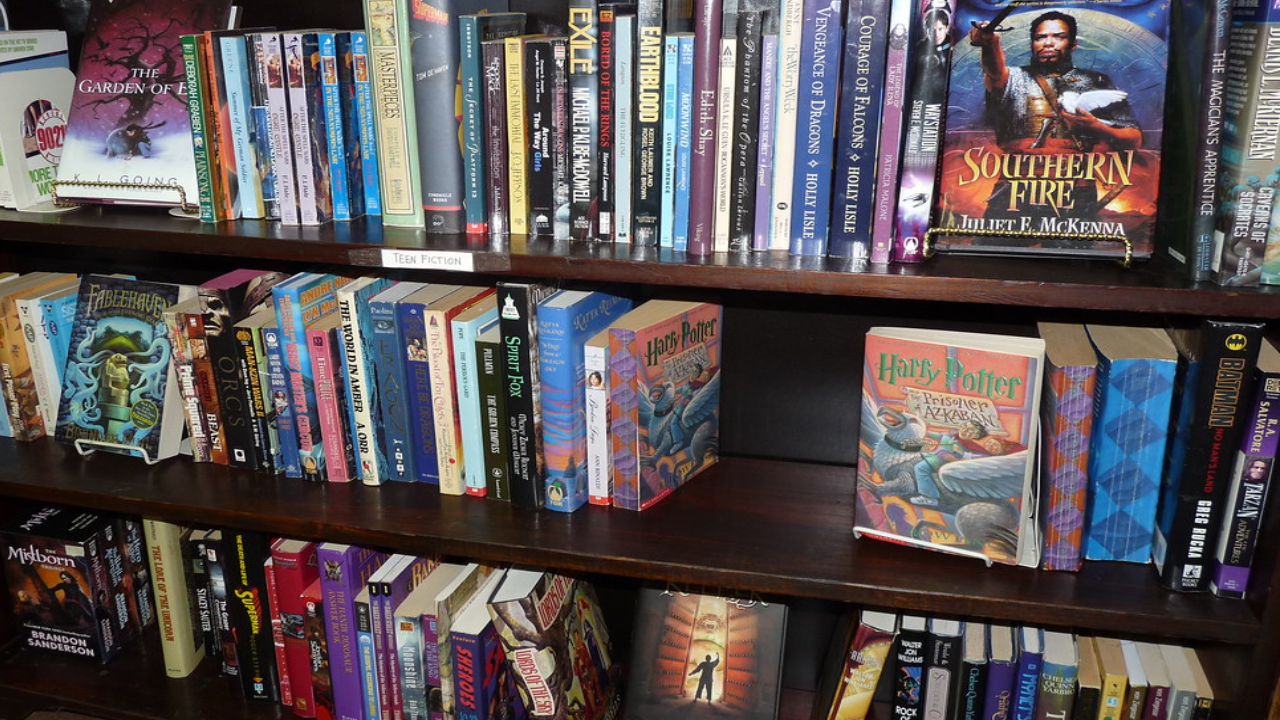
Young adult books, shortened as YA, address the particular experiences and issues that teenagers endure, often ranging in age from 12 to 18. These books address a wide range of topics, including identity, friendship, romance, family dynamics, and societal challenges, which resonate with readers navigating the complexity of adolescence.
Young adult books covers a wide range of genres, from contemporary realism to fantasy and dystopian fiction, giving readers a comprehensive variety. With relatable protagonists and intriguing plots, YA literature allow young readers to reflect, empathize, and empower themselves as they negotiate the arduous road of puberty.
The Misunderstood World of Young Adult Books
Young adult books is sometimes misunderstood by non-fans. Many people perceive it (incorrectly) as a formulaic category with well-known elements in various packaging.
Understanding those tropes and your reader’s expectations, and subverting them in ways that only you can, is what elevates YA books from formulaic to revolutionary, and cements your characters in the hearts of YA fans all around the world.
But first, let’s go over the essentials…
Basics of writing good young adult fiction Understanding Your Reader
Young adult books readers are discerning: they are well-versed in their genre and read across it. They love and loathe every stereotype, are involved in their neighborhood, and are interested in the larger context of the globe.
It’s what makes writing for them so exciting: they’ll challenge and push you to think in new ways since that’s how they think. They’re constantly questioning the institutions that keep the world running, as well as the things their parents and loved ones have taught them to be true, and are always on the lookout for new perspectives on old ideas. They read young adult books because they want to feel.
Keeping your readers’ identities and desires in mind is essential for creating captivating YA; don’t underestimate them or over-explain things to them. Trust them: they’ll notice everything about your job in the greatest way possible!
Characters and emotional depth among young adults
Though your plot must be fast-paced to keep your reader involved, young adult books fiction readers are most interested in your characters.
At this moment in your readers’ lives, they are experiencing some of the most intense feelings a human can feel for the first time: first love, first heartbreak, and first righteous fury!
Emotion, growth, and evolution are central to all of your readers’ experiences; everything feels like the most essential thing in the world, because it truly is for their path into adulthood.
Many of the novels that became viral on TikTok, even years after they were released, promised to ’emotionally destroy’ its readers. And this is because, for many young adults books readers, young adult books fiction provides a safe environment to express their deepest emotions without fear of being personally injured. This is why, even when many young adult books readers age out of the category, they continue to buy YA alongside adult literature.
With this in mind, your viewers are looking for characters to love, develop with, and attempt to understand. The typical young adult reader rereads their favorite books. They’re also more inclined to read and write their own fan fiction since they prefer active involvement with favorite characters and settings than passive adoration, and they’ll look at your work from every perspective.
So readers are familiar with the clichéd characters that frequently appear in YA; to write genuinely breakthrough young adult books/stories, you must defy convention and provide them with some of what they anticipate, as well as something new that only you, with your unique personal past, can incorporate into your characters.
Escapism and reader security
Young adult books consumers can be stubborn when they find a writer who can meticulously build a universe because what they seek (in the current market) is escapism. This applies to all genres, including romance, fantasy, murder mystery, horror, and sci-fi; the ultimate goal is the same.
Understanding why and how to achieve the escapism quotient while remaining grounded in reality is how you ensure your young adult books fiction hits the mark.
The world is utterly insane: we’re all living through and watching horrific global events, and with the climate crumbling, the future isn’t as bright as it once was.
This is the context within which you are giving escape, and it is critical to remember this in order to do so appropriately.
Regarding fantasy…
Even though many of the young adult books people are reading contain tragedy, revolutions, despots, and evil, the overall expectation is that we’ll see the good guys come close to prevailing or at least some sort of justice being served.
One of the best young adult books editors in the business once told me that what truly distinguishes adult fiction from young adult books is that YA promises hope, which you must deliver on. I’m not saying they’re guaranteed a happy ending, but they’re expecting it to feel like the characters helped make their world a little better, either by finding each other and falling in love despite terrible circumstances, by finding the courage to stand up for what’s right, or by helping free their world from some evil that leads to a brighter future.
For a romantic moment…

When it comes to modern stories, particularly romance, I recommend works like Heartstopper.
Aside from the grassroots method of growing her graphic book following online before submitting it to publishers, what Alice Oseman did here was pioneering in terms of plot handling.
She created a cast of memorable, lovable, and wholesome characters, the majority of whom are LGBTQIA+, and investigated how they were able to create safety and happiness together in order to tackle difficult issues such as eating disorders, homophobia at home and school, narcissistic parenting, and transphobia.
She handled this in such a manner that it didn’t feel like their challenges were the most important aspect of who they were or what characterized them, but rather their pursuit of love and happiness. The focus was on the connections they formed along the journey, so the reading (and now watching) experience was immensely positive – escapist and pure, with actual, true representation at its core.
Following this formula, you create an escapist sense of romance, of budding first love between brilliantly diverse characters, you lightly touch on the darker things they must overcome in order to be together, and you ensure that your audience leaves with a big cheesy grin at the end of your story (and the desire to immediately check out fan fiction on AO3).
For grittier tales…
For more gritty current storylines, the problem is to make the plot feel bearable and as if your main character isn’t going through it alone. Character is important here, and attempt to provide a more modern perspective to what you’re exploring. Whether it’s cold case murder mysteries, gritty urban thrillers, family and societal dramas, or something else, the process of discovery must still feel worthwhile, and we must be able to root for a certain character.
So provide your reader with safety and escapism while also trusting them to handle some of the harsher issues at that distance.
How to write innovative young adult books
We’ve discussed the good, but what about the groundbreaking? The novels that defy conventions, twist cliches, and propel the genre forward. pushing everything into account, I’ve compiled four suggestions for pushing your young adult novel to the next level:
Consider what you intend to say
Every book is written because the author has something to express. The story itself always conveys a set of principles or something that people can come to care about in some little way.
Don’t beat us over the head with it; trust your YA reader, but be explicit about what it is and how it relates to everything when you’re plotting.
Subvert tropes
The big one! Friends-to-lovers, enemies-to-lovers, the one-bed trope, the best buddy sidekick, the chosen one, the stoic masc soldier, the quippy one-liner pal who doesn’t seem to do much else… I could go on!
Many cherished and despised clichés are important to young adult literature. Readers want the familiar, but better. It’s subverted to feel more fresh. This is where the ground-breaking happens.
What traditional YA stereotypes are now prevalent in your book? How can you twist what you want to communicate and use your distinct voice to make it unique? Here’s where I recommend you look through TikTok to observe how people are reacting to the tropes you’ve used. What do they think is wonderful, and what do they think is overdone? What does not seem to belong in today’s society?
Keep an eye on the market
Four years ago, emerging voices in young adult novels were fighting to break through amid established brand authors. Now, thanks to a new algorithm from TikTok, publishers can link directly with how people discover new books – therefore you should look into it as well.
BookTokkers categorize novels based on aesthetics, levels of devastation at the conclusion, and how they felt after reading them. Genres have gotten increasingly precise, allowing readers to identify their specialty. Booksellers are taking note and highlighting their favorite young adult books love triangle or body horror.
Get to know your audience

As much as your publisher and agent may have a wonderful strategy for your work, it is critical that you do as well, so that they understand it when they pick up the book.
Consider this year’s YA debut UK bestseller Girl, Goddess, Queen. The author, Bea Fitzgerald, is a popular TikTok developer who specializes in hilarious stuff about Greek gods.
She was able to determine exactly what type of content resonated with her readership, which lead her to write her book: a reworking of the traditional tale of Hades and Persephone that empowers Persephone in ways that the myth does not, making it more appealing to modern audiences. With enough of heat and a phony dating stereotype tossed in, she captivated YA readers!
It is a wonderful success story, and her pitch and market understanding were so obvious that her team was able to enable that vision, resulting in the young adult books well-deserved success.
So go forth, develop your own message, investigate your young adult novels, get to know your readers, and then surprise them with something unexpected.
Three unforeseen Advantages of Reading for Pleasure as an Adult




